Operation & Project Management: Analysis of Next Plc's Methodologies
VerifiedAdded on 2023/06/13
|21
|6032
|368
Report
AI Summary
This report provides an in-depth analysis of operations and project management principles implemented by Next Plc, a British multinational brand. It begins with an introduction to Next Plc, highlighting its global presence and key business areas. The report differentiates between operation and operations management, emphasizing the importance of efficient resource utilization for profit maximization. It reviews and critiques Next Plc's implementation of operations management principles, focusing on reality, organization, and accountability. The application of Six Sigma methodology, including the DMAIC process, is discussed in the context of improving processes and addressing challenges like changing consumer behavior. Lean principles, such as value identification, are also examined. Furthermore, the report explores the application of each stage of the Project Life Cycle (PLC) to a project requiring documentation support, analyzing project methodologies and tools used. Finally, it critically evaluates the effectiveness of the PLC, providing a comprehensive overview of Next Plc's operational and project management strategies.
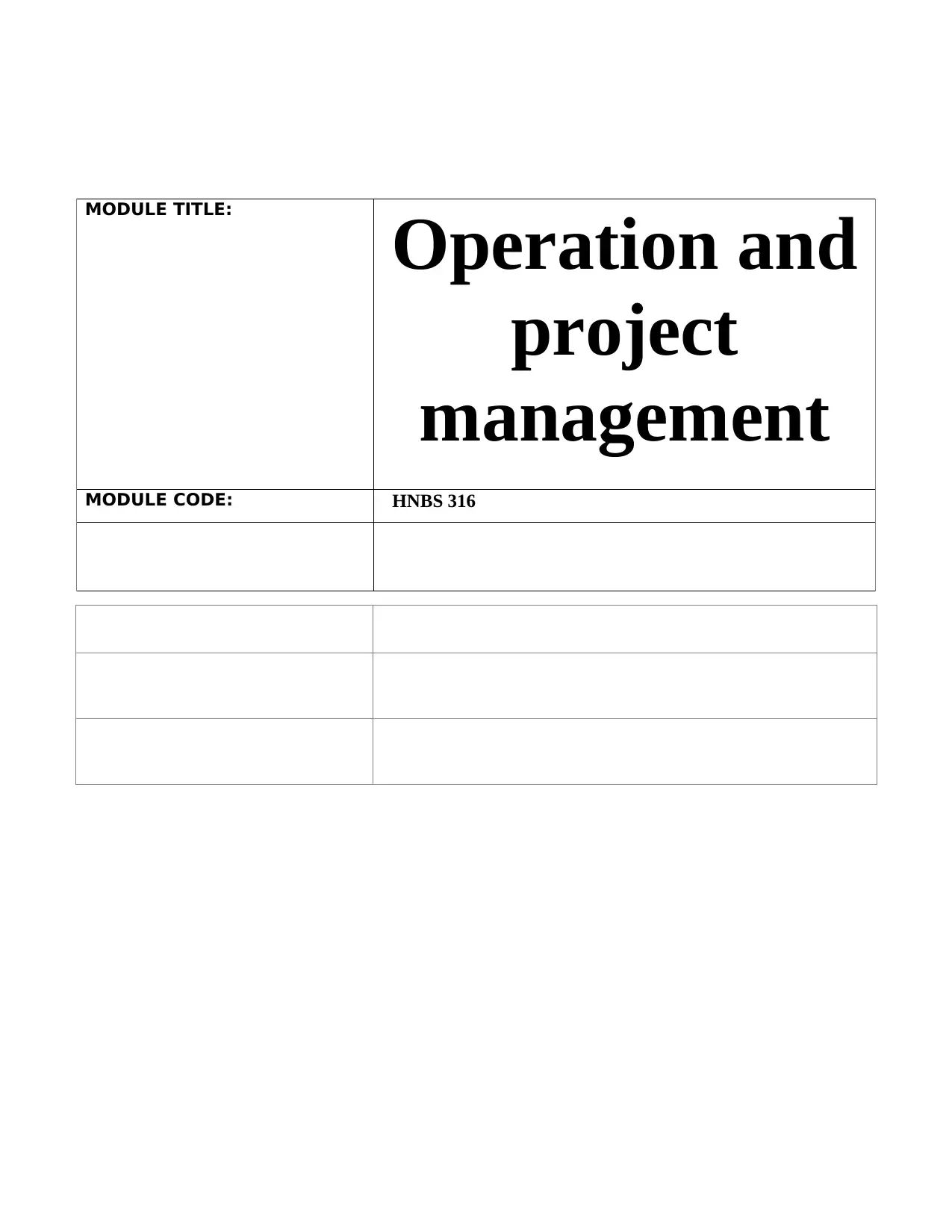
MODULE TITLE:
Operation and
project
management
MODULE CODE: HNBS 316
Operation and
project
management
MODULE CODE: HNBS 316
Paraphrase This Document
Need a fresh take? Get an instant paraphrase of this document with our AI Paraphraser
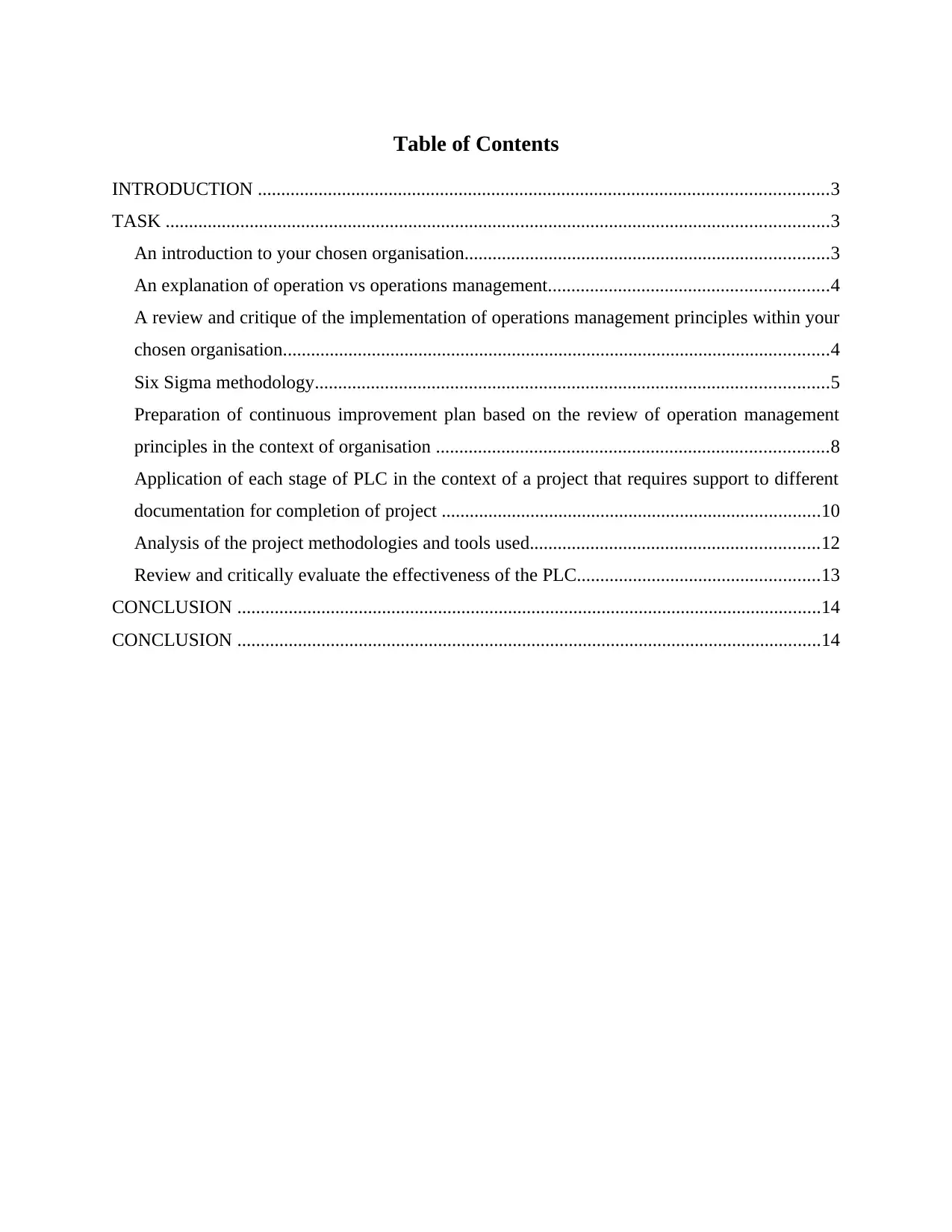
Table of Contents
INTRODUCTION ..........................................................................................................................3
TASK ..............................................................................................................................................3
An introduction to your chosen organisation..............................................................................3
An explanation of operation vs operations management............................................................4
A review and critique of the implementation of operations management principles within your
chosen organisation.....................................................................................................................4
Six Sigma methodology..............................................................................................................5
Preparation of continuous improvement plan based on the review of operation management
principles in the context of organisation ....................................................................................8
Application of each stage of PLC in the context of a project that requires support to different
documentation for completion of project .................................................................................10
Analysis of the project methodologies and tools used..............................................................12
Review and critically evaluate the effectiveness of the PLC....................................................13
CONCLUSION .............................................................................................................................14
CONCLUSION .............................................................................................................................14
INTRODUCTION ..........................................................................................................................3
TASK ..............................................................................................................................................3
An introduction to your chosen organisation..............................................................................3
An explanation of operation vs operations management............................................................4
A review and critique of the implementation of operations management principles within your
chosen organisation.....................................................................................................................4
Six Sigma methodology..............................................................................................................5
Preparation of continuous improvement plan based on the review of operation management
principles in the context of organisation ....................................................................................8
Application of each stage of PLC in the context of a project that requires support to different
documentation for completion of project .................................................................................10
Analysis of the project methodologies and tools used..............................................................12
Review and critically evaluate the effectiveness of the PLC....................................................13
CONCLUSION .............................................................................................................................14
CONCLUSION .............................................................................................................................14
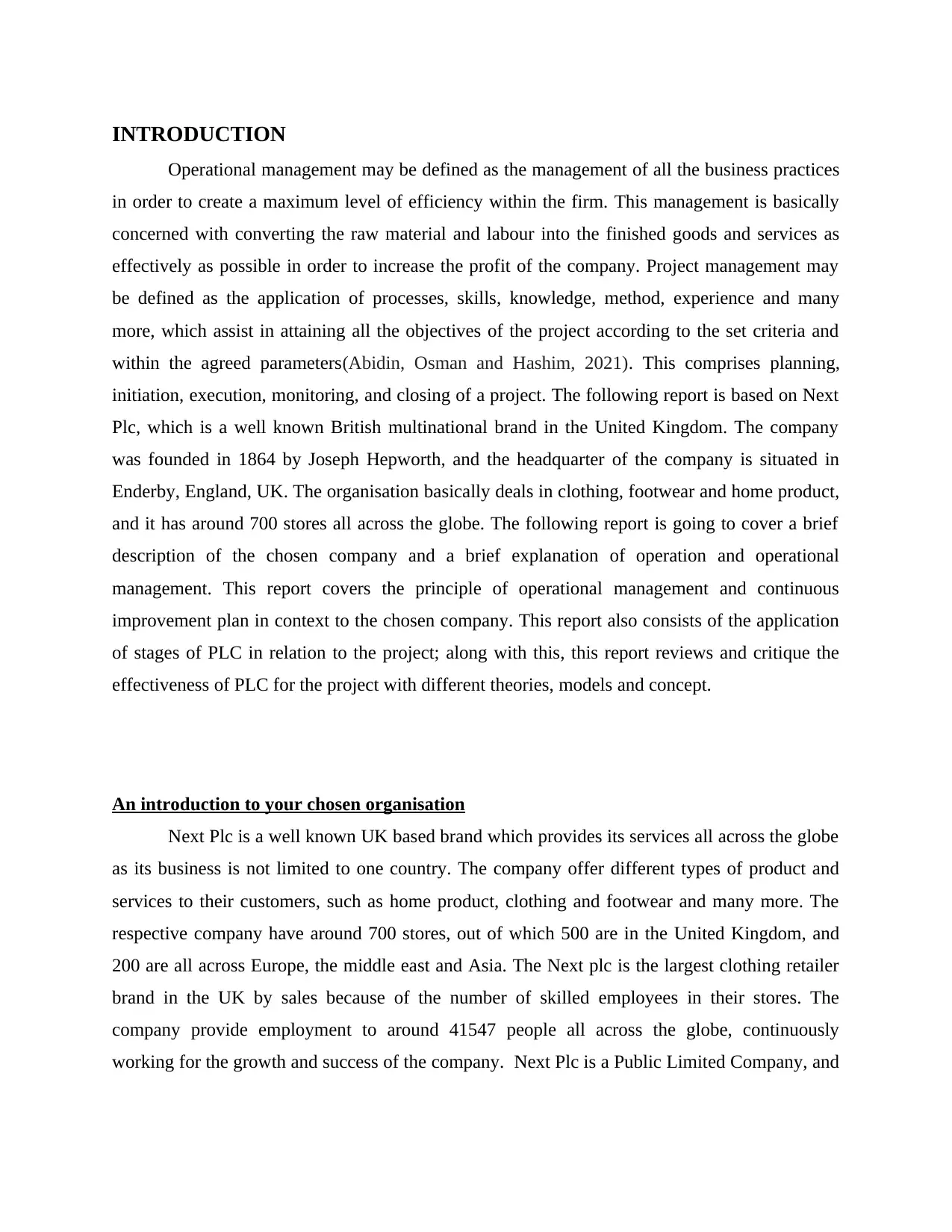
INTRODUCTION
Operational management may be defined as the management of all the business practices
in order to create a maximum level of efficiency within the firm. This management is basically
concerned with converting the raw material and labour into the finished goods and services as
effectively as possible in order to increase the profit of the company. Project management may
be defined as the application of processes, skills, knowledge, method, experience and many
more, which assist in attaining all the objectives of the project according to the set criteria and
within the agreed parameters(Abidin, Osman and Hashim, 2021). This comprises planning,
initiation, execution, monitoring, and closing of a project. The following report is based on Next
Plc, which is a well known British multinational brand in the United Kingdom. The company
was founded in 1864 by Joseph Hepworth, and the headquarter of the company is situated in
Enderby, England, UK. The organisation basically deals in clothing, footwear and home product,
and it has around 700 stores all across the globe. The following report is going to cover a brief
description of the chosen company and a brief explanation of operation and operational
management. This report covers the principle of operational management and continuous
improvement plan in context to the chosen company. This report also consists of the application
of stages of PLC in relation to the project; along with this, this report reviews and critique the
effectiveness of PLC for the project with different theories, models and concept.
An introduction to your chosen organisation
Next Plc is a well known UK based brand which provides its services all across the globe
as its business is not limited to one country. The company offer different types of product and
services to their customers, such as home product, clothing and footwear and many more. The
respective company have around 700 stores, out of which 500 are in the United Kingdom, and
200 are all across Europe, the middle east and Asia. The Next plc is the largest clothing retailer
brand in the UK by sales because of the number of skilled employees in their stores. The
company provide employment to around 41547 people all across the globe, continuously
working for the growth and success of the company. Next Plc is a Public Limited Company, and
Operational management may be defined as the management of all the business practices
in order to create a maximum level of efficiency within the firm. This management is basically
concerned with converting the raw material and labour into the finished goods and services as
effectively as possible in order to increase the profit of the company. Project management may
be defined as the application of processes, skills, knowledge, method, experience and many
more, which assist in attaining all the objectives of the project according to the set criteria and
within the agreed parameters(Abidin, Osman and Hashim, 2021). This comprises planning,
initiation, execution, monitoring, and closing of a project. The following report is based on Next
Plc, which is a well known British multinational brand in the United Kingdom. The company
was founded in 1864 by Joseph Hepworth, and the headquarter of the company is situated in
Enderby, England, UK. The organisation basically deals in clothing, footwear and home product,
and it has around 700 stores all across the globe. The following report is going to cover a brief
description of the chosen company and a brief explanation of operation and operational
management. This report covers the principle of operational management and continuous
improvement plan in context to the chosen company. This report also consists of the application
of stages of PLC in relation to the project; along with this, this report reviews and critique the
effectiveness of PLC for the project with different theories, models and concept.
An introduction to your chosen organisation
Next Plc is a well known UK based brand which provides its services all across the globe
as its business is not limited to one country. The company offer different types of product and
services to their customers, such as home product, clothing and footwear and many more. The
respective company have around 700 stores, out of which 500 are in the United Kingdom, and
200 are all across Europe, the middle east and Asia. The Next plc is the largest clothing retailer
brand in the UK by sales because of the number of skilled employees in their stores. The
company provide employment to around 41547 people all across the globe, continuously
working for the growth and success of the company. Next Plc is a Public Limited Company, and
⊘ This is a preview!⊘
Do you want full access?
Subscribe today to unlock all pages.

Trusted by 1+ million students worldwide
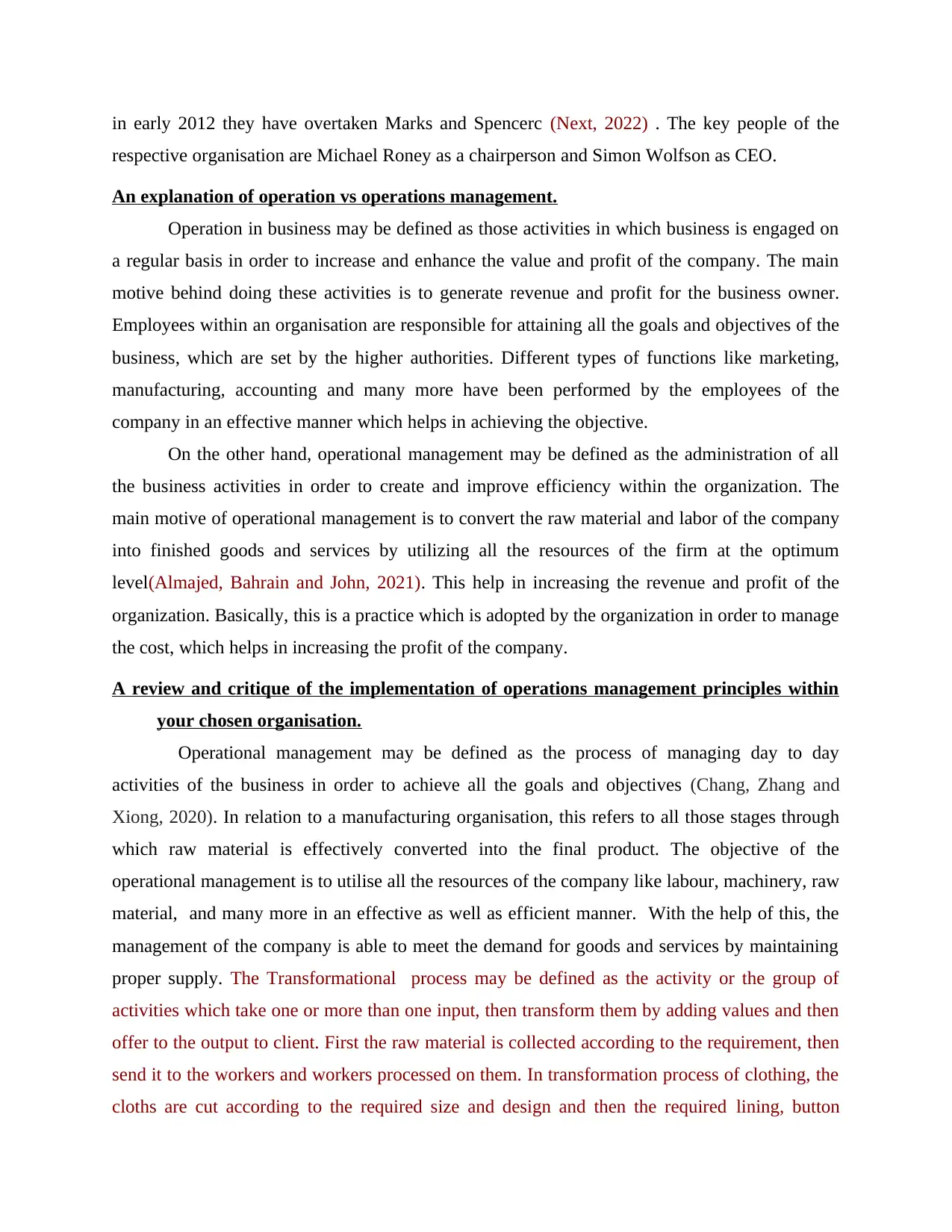
in early 2012 they have overtaken Marks and Spencerc (Next, 2022) . The key people of the
respective organisation are Michael Roney as a chairperson and Simon Wolfson as CEO.
An explanation of operation vs operations management.
Operation in business may be defined as those activities in which business is engaged on
a regular basis in order to increase and enhance the value and profit of the company. The main
motive behind doing these activities is to generate revenue and profit for the business owner.
Employees within an organisation are responsible for attaining all the goals and objectives of the
business, which are set by the higher authorities. Different types of functions like marketing,
manufacturing, accounting and many more have been performed by the employees of the
company in an effective manner which helps in achieving the objective.
On the other hand, operational management may be defined as the administration of all
the business activities in order to create and improve efficiency within the organization. The
main motive of operational management is to convert the raw material and labor of the company
into finished goods and services by utilizing all the resources of the firm at the optimum
level(Almajed, Bahrain and John, 2021). This help in increasing the revenue and profit of the
organization. Basically, this is a practice which is adopted by the organization in order to manage
the cost, which helps in increasing the profit of the company.
A review and critique of the implementation of operations management principles within
your chosen organisation.
Operational management may be defined as the process of managing day to day
activities of the business in order to achieve all the goals and objectives (Chang, Zhang and
Xiong, 2020). In relation to a manufacturing organisation, this refers to all those stages through
which raw material is effectively converted into the final product. The objective of the
operational management is to utilise all the resources of the company like labour, machinery, raw
material, and many more in an effective as well as efficient manner. With the help of this, the
management of the company is able to meet the demand for goods and services by maintaining
proper supply. The Transformational process may be defined as the activity or the group of
activities which take one or more than one input, then transform them by adding values and then
offer to the output to client. First the raw material is collected according to the requirement, then
send it to the workers and workers processed on them. In transformation process of clothing, the
cloths are cut according to the required size and design and then the required lining, button
respective organisation are Michael Roney as a chairperson and Simon Wolfson as CEO.
An explanation of operation vs operations management.
Operation in business may be defined as those activities in which business is engaged on
a regular basis in order to increase and enhance the value and profit of the company. The main
motive behind doing these activities is to generate revenue and profit for the business owner.
Employees within an organisation are responsible for attaining all the goals and objectives of the
business, which are set by the higher authorities. Different types of functions like marketing,
manufacturing, accounting and many more have been performed by the employees of the
company in an effective manner which helps in achieving the objective.
On the other hand, operational management may be defined as the administration of all
the business activities in order to create and improve efficiency within the organization. The
main motive of operational management is to convert the raw material and labor of the company
into finished goods and services by utilizing all the resources of the firm at the optimum
level(Almajed, Bahrain and John, 2021). This help in increasing the revenue and profit of the
organization. Basically, this is a practice which is adopted by the organization in order to manage
the cost, which helps in increasing the profit of the company.
A review and critique of the implementation of operations management principles within
your chosen organisation.
Operational management may be defined as the process of managing day to day
activities of the business in order to achieve all the goals and objectives (Chang, Zhang and
Xiong, 2020). In relation to a manufacturing organisation, this refers to all those stages through
which raw material is effectively converted into the final product. The objective of the
operational management is to utilise all the resources of the company like labour, machinery, raw
material, and many more in an effective as well as efficient manner. With the help of this, the
management of the company is able to meet the demand for goods and services by maintaining
proper supply. The Transformational process may be defined as the activity or the group of
activities which take one or more than one input, then transform them by adding values and then
offer to the output to client. First the raw material is collected according to the requirement, then
send it to the workers and workers processed on them. In transformation process of clothing, the
cloths are cut according to the required size and design and then the required lining, button
Paraphrase This Document
Need a fresh take? Get an instant paraphrase of this document with our AI Paraphraser
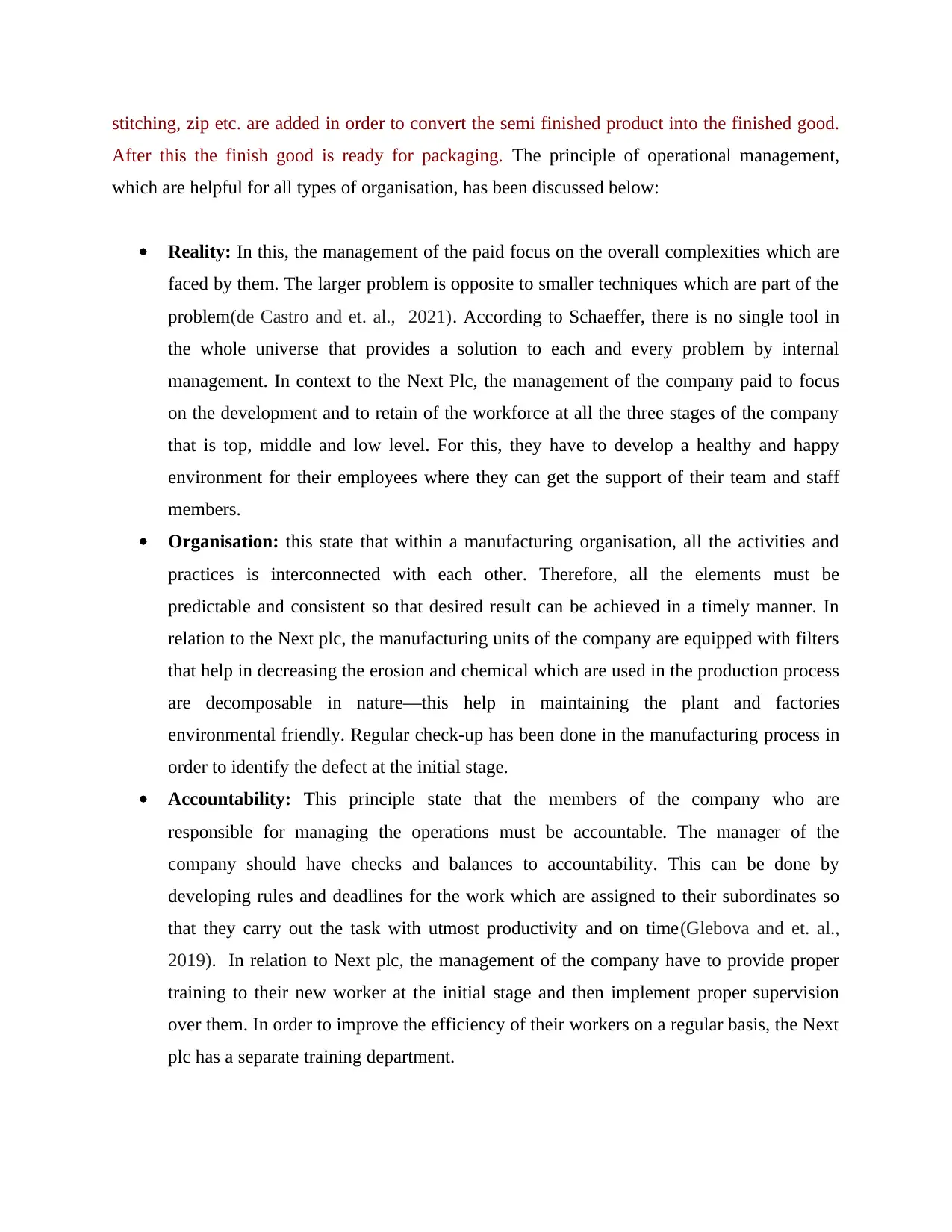
stitching, zip etc. are added in order to convert the semi finished product into the finished good.
After this the finish good is ready for packaging. The principle of operational management,
which are helpful for all types of organisation, has been discussed below:
Reality: In this, the management of the paid focus on the overall complexities which are
faced by them. The larger problem is opposite to smaller techniques which are part of the
problem(de Castro and et. al., 2021). According to Schaeffer, there is no single tool in
the whole universe that provides a solution to each and every problem by internal
management. In context to the Next Plc, the management of the company paid to focus
on the development and to retain of the workforce at all the three stages of the company
that is top, middle and low level. For this, they have to develop a healthy and happy
environment for their employees where they can get the support of their team and staff
members.
Organisation: this state that within a manufacturing organisation, all the activities and
practices is interconnected with each other. Therefore, all the elements must be
predictable and consistent so that desired result can be achieved in a timely manner. In
relation to the Next plc, the manufacturing units of the company are equipped with filters
that help in decreasing the erosion and chemical which are used in the production process
are decomposable in nature—this help in maintaining the plant and factories
environmental friendly. Regular check-up has been done in the manufacturing process in
order to identify the defect at the initial stage.
Accountability: This principle state that the members of the company who are
responsible for managing the operations must be accountable. The manager of the
company should have checks and balances to accountability. This can be done by
developing rules and deadlines for the work which are assigned to their subordinates so
that they carry out the task with utmost productivity and on time(Glebova and et. al.,
2019). In relation to Next plc, the management of the company have to provide proper
training to their new worker at the initial stage and then implement proper supervision
over them. In order to improve the efficiency of their workers on a regular basis, the Next
plc has a separate training department.
After this the finish good is ready for packaging. The principle of operational management,
which are helpful for all types of organisation, has been discussed below:
Reality: In this, the management of the paid focus on the overall complexities which are
faced by them. The larger problem is opposite to smaller techniques which are part of the
problem(de Castro and et. al., 2021). According to Schaeffer, there is no single tool in
the whole universe that provides a solution to each and every problem by internal
management. In context to the Next Plc, the management of the company paid to focus
on the development and to retain of the workforce at all the three stages of the company
that is top, middle and low level. For this, they have to develop a healthy and happy
environment for their employees where they can get the support of their team and staff
members.
Organisation: this state that within a manufacturing organisation, all the activities and
practices is interconnected with each other. Therefore, all the elements must be
predictable and consistent so that desired result can be achieved in a timely manner. In
relation to the Next plc, the manufacturing units of the company are equipped with filters
that help in decreasing the erosion and chemical which are used in the production process
are decomposable in nature—this help in maintaining the plant and factories
environmental friendly. Regular check-up has been done in the manufacturing process in
order to identify the defect at the initial stage.
Accountability: This principle state that the members of the company who are
responsible for managing the operations must be accountable. The manager of the
company should have checks and balances to accountability. This can be done by
developing rules and deadlines for the work which are assigned to their subordinates so
that they carry out the task with utmost productivity and on time(Glebova and et. al.,
2019). In relation to Next plc, the management of the company have to provide proper
training to their new worker at the initial stage and then implement proper supervision
over them. In order to improve the efficiency of their workers on a regular basis, the Next
plc has a separate training department.
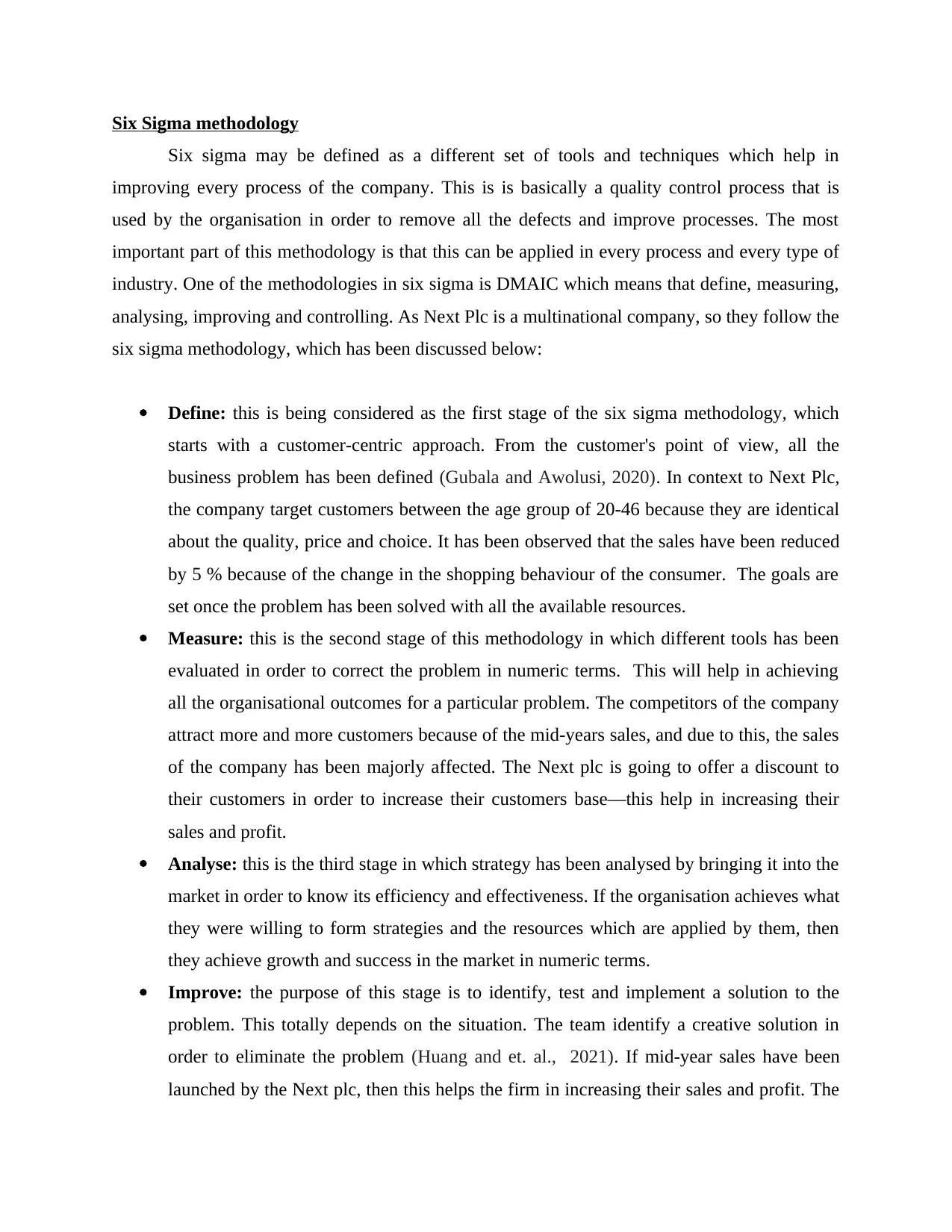
Six Sigma methodology
Six sigma may be defined as a different set of tools and techniques which help in
improving every process of the company. This is is basically a quality control process that is
used by the organisation in order to remove all the defects and improve processes. The most
important part of this methodology is that this can be applied in every process and every type of
industry. One of the methodologies in six sigma is DMAIC which means that define, measuring,
analysing, improving and controlling. As Next Plc is a multinational company, so they follow the
six sigma methodology, which has been discussed below:
Define: this is being considered as the first stage of the six sigma methodology, which
starts with a customer-centric approach. From the customer's point of view, all the
business problem has been defined (Gubala and Awolusi, 2020). In context to Next Plc,
the company target customers between the age group of 20-46 because they are identical
about the quality, price and choice. It has been observed that the sales have been reduced
by 5 % because of the change in the shopping behaviour of the consumer. The goals are
set once the problem has been solved with all the available resources.
Measure: this is the second stage of this methodology in which different tools has been
evaluated in order to correct the problem in numeric terms. This will help in achieving
all the organisational outcomes for a particular problem. The competitors of the company
attract more and more customers because of the mid-years sales, and due to this, the sales
of the company has been majorly affected. The Next plc is going to offer a discount to
their customers in order to increase their customers base—this help in increasing their
sales and profit.
Analyse: this is the third stage in which strategy has been analysed by bringing it into the
market in order to know its efficiency and effectiveness. If the organisation achieves what
they were willing to form strategies and the resources which are applied by them, then
they achieve growth and success in the market in numeric terms.
Improve: the purpose of this stage is to identify, test and implement a solution to the
problem. This totally depends on the situation. The team identify a creative solution in
order to eliminate the problem (Huang and et. al., 2021). If mid-year sales have been
launched by the Next plc, then this helps the firm in increasing their sales and profit. The
Six sigma may be defined as a different set of tools and techniques which help in
improving every process of the company. This is is basically a quality control process that is
used by the organisation in order to remove all the defects and improve processes. The most
important part of this methodology is that this can be applied in every process and every type of
industry. One of the methodologies in six sigma is DMAIC which means that define, measuring,
analysing, improving and controlling. As Next Plc is a multinational company, so they follow the
six sigma methodology, which has been discussed below:
Define: this is being considered as the first stage of the six sigma methodology, which
starts with a customer-centric approach. From the customer's point of view, all the
business problem has been defined (Gubala and Awolusi, 2020). In context to Next Plc,
the company target customers between the age group of 20-46 because they are identical
about the quality, price and choice. It has been observed that the sales have been reduced
by 5 % because of the change in the shopping behaviour of the consumer. The goals are
set once the problem has been solved with all the available resources.
Measure: this is the second stage of this methodology in which different tools has been
evaluated in order to correct the problem in numeric terms. This will help in achieving
all the organisational outcomes for a particular problem. The competitors of the company
attract more and more customers because of the mid-years sales, and due to this, the sales
of the company has been majorly affected. The Next plc is going to offer a discount to
their customers in order to increase their customers base—this help in increasing their
sales and profit.
Analyse: this is the third stage in which strategy has been analysed by bringing it into the
market in order to know its efficiency and effectiveness. If the organisation achieves what
they were willing to form strategies and the resources which are applied by them, then
they achieve growth and success in the market in numeric terms.
Improve: the purpose of this stage is to identify, test and implement a solution to the
problem. This totally depends on the situation. The team identify a creative solution in
order to eliminate the problem (Huang and et. al., 2021). If mid-year sales have been
launched by the Next plc, then this helps the firm in increasing their sales and profit. The
⊘ This is a preview!⊘
Do you want full access?
Subscribe today to unlock all pages.

Trusted by 1+ million students worldwide
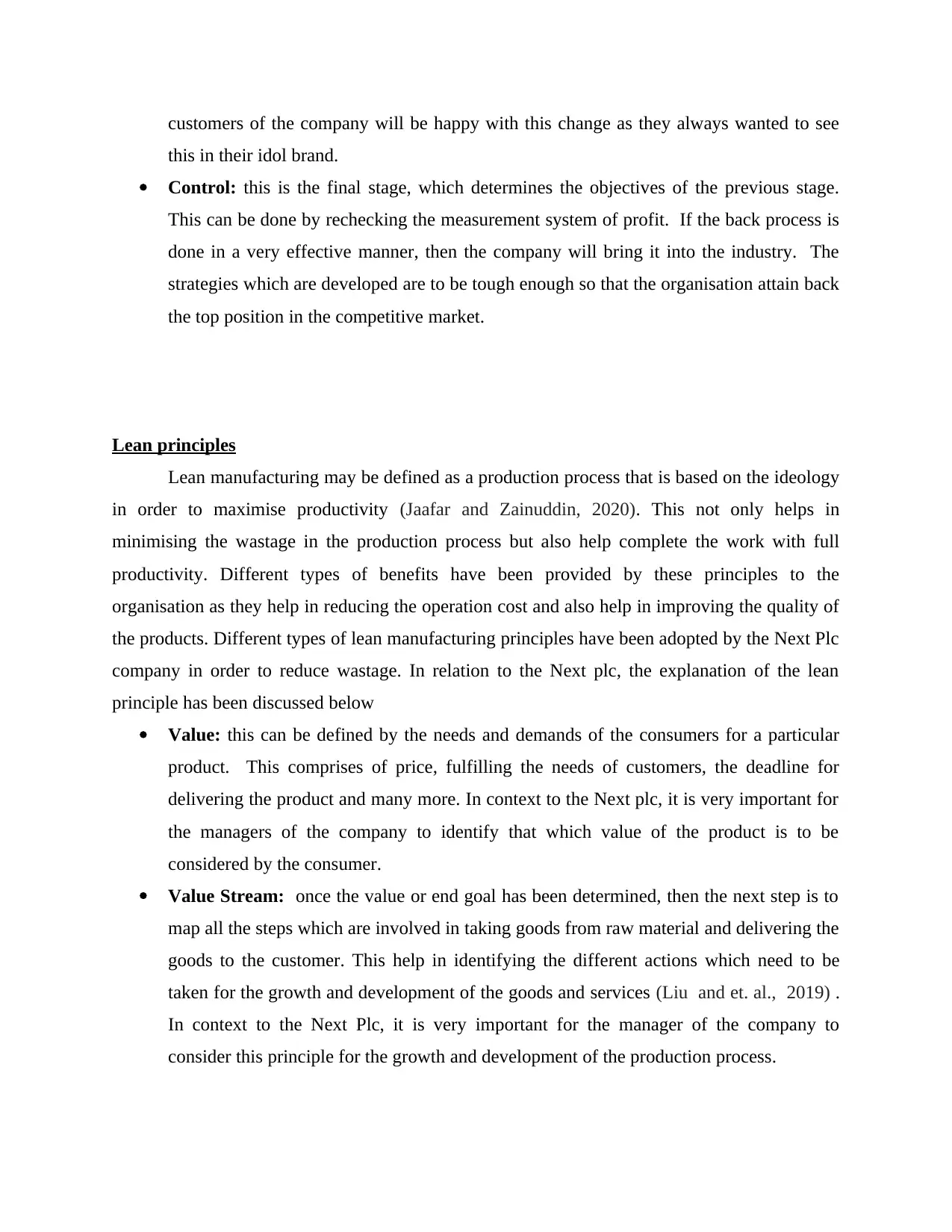
customers of the company will be happy with this change as they always wanted to see
this in their idol brand.
Control: this is the final stage, which determines the objectives of the previous stage.
This can be done by rechecking the measurement system of profit. If the back process is
done in a very effective manner, then the company will bring it into the industry. The
strategies which are developed are to be tough enough so that the organisation attain back
the top position in the competitive market.
Lean principles
Lean manufacturing may be defined as a production process that is based on the ideology
in order to maximise productivity (Jaafar and Zainuddin, 2020). This not only helps in
minimising the wastage in the production process but also help complete the work with full
productivity. Different types of benefits have been provided by these principles to the
organisation as they help in reducing the operation cost and also help in improving the quality of
the products. Different types of lean manufacturing principles have been adopted by the Next Plc
company in order to reduce wastage. In relation to the Next plc, the explanation of the lean
principle has been discussed below
Value: this can be defined by the needs and demands of the consumers for a particular
product. This comprises of price, fulfilling the needs of customers, the deadline for
delivering the product and many more. In context to the Next plc, it is very important for
the managers of the company to identify that which value of the product is to be
considered by the consumer.
Value Stream: once the value or end goal has been determined, then the next step is to
map all the steps which are involved in taking goods from raw material and delivering the
goods to the customer. This help in identifying the different actions which need to be
taken for the growth and development of the goods and services (Liu and et. al., 2019) .
In context to the Next Plc, it is very important for the manager of the company to
consider this principle for the growth and development of the production process.
this in their idol brand.
Control: this is the final stage, which determines the objectives of the previous stage.
This can be done by rechecking the measurement system of profit. If the back process is
done in a very effective manner, then the company will bring it into the industry. The
strategies which are developed are to be tough enough so that the organisation attain back
the top position in the competitive market.
Lean principles
Lean manufacturing may be defined as a production process that is based on the ideology
in order to maximise productivity (Jaafar and Zainuddin, 2020). This not only helps in
minimising the wastage in the production process but also help complete the work with full
productivity. Different types of benefits have been provided by these principles to the
organisation as they help in reducing the operation cost and also help in improving the quality of
the products. Different types of lean manufacturing principles have been adopted by the Next Plc
company in order to reduce wastage. In relation to the Next plc, the explanation of the lean
principle has been discussed below
Value: this can be defined by the needs and demands of the consumers for a particular
product. This comprises of price, fulfilling the needs of customers, the deadline for
delivering the product and many more. In context to the Next plc, it is very important for
the managers of the company to identify that which value of the product is to be
considered by the consumer.
Value Stream: once the value or end goal has been determined, then the next step is to
map all the steps which are involved in taking goods from raw material and delivering the
goods to the customer. This help in identifying the different actions which need to be
taken for the growth and development of the goods and services (Liu and et. al., 2019) .
In context to the Next Plc, it is very important for the manager of the company to
consider this principle for the growth and development of the production process.
Paraphrase This Document
Need a fresh take? Get an instant paraphrase of this document with our AI Paraphraser
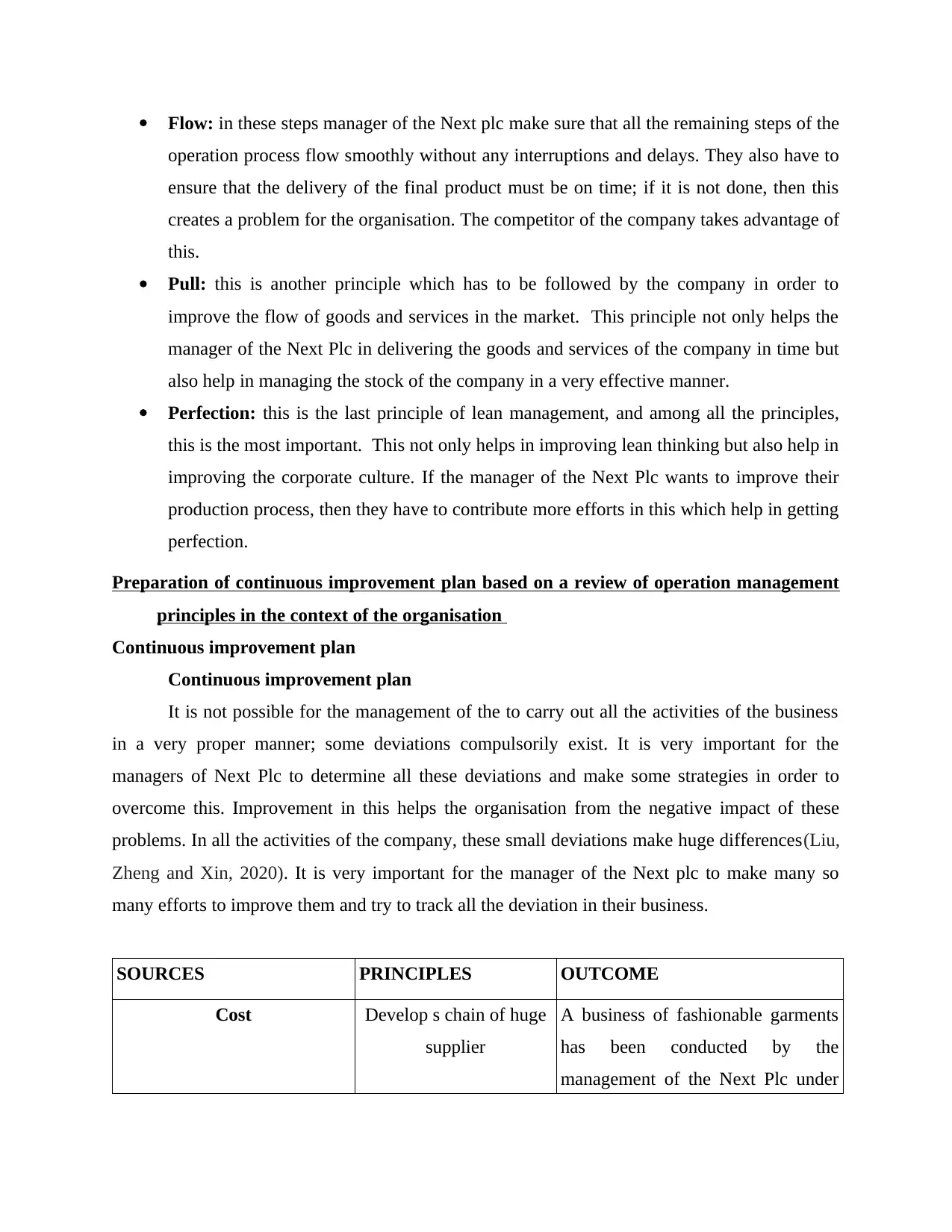
Flow: in these steps manager of the Next plc make sure that all the remaining steps of the
operation process flow smoothly without any interruptions and delays. They also have to
ensure that the delivery of the final product must be on time; if it is not done, then this
creates a problem for the organisation. The competitor of the company takes advantage of
this.
Pull: this is another principle which has to be followed by the company in order to
improve the flow of goods and services in the market. This principle not only helps the
manager of the Next Plc in delivering the goods and services of the company in time but
also help in managing the stock of the company in a very effective manner.
Perfection: this is the last principle of lean management, and among all the principles,
this is the most important. This not only helps in improving lean thinking but also help in
improving the corporate culture. If the manager of the Next Plc wants to improve their
production process, then they have to contribute more efforts in this which help in getting
perfection.
Preparation of continuous improvement plan based on a review of operation management
principles in the context of the organisation
Continuous improvement plan
Continuous improvement plan
It is not possible for the management of the to carry out all the activities of the business
in a very proper manner; some deviations compulsorily exist. It is very important for the
managers of Next Plc to determine all these deviations and make some strategies in order to
overcome this. Improvement in this helps the organisation from the negative impact of these
problems. In all the activities of the company, these small deviations make huge differences(Liu,
Zheng and Xin, 2020). It is very important for the manager of the Next plc to make many so
many efforts to improve them and try to track all the deviation in their business.
SOURCES PRINCIPLES OUTCOME
Cost Develop s chain of huge
supplier
A business of fashionable garments
has been conducted by the
management of the Next Plc under
operation process flow smoothly without any interruptions and delays. They also have to
ensure that the delivery of the final product must be on time; if it is not done, then this
creates a problem for the organisation. The competitor of the company takes advantage of
this.
Pull: this is another principle which has to be followed by the company in order to
improve the flow of goods and services in the market. This principle not only helps the
manager of the Next Plc in delivering the goods and services of the company in time but
also help in managing the stock of the company in a very effective manner.
Perfection: this is the last principle of lean management, and among all the principles,
this is the most important. This not only helps in improving lean thinking but also help in
improving the corporate culture. If the manager of the Next Plc wants to improve their
production process, then they have to contribute more efforts in this which help in getting
perfection.
Preparation of continuous improvement plan based on a review of operation management
principles in the context of the organisation
Continuous improvement plan
Continuous improvement plan
It is not possible for the management of the to carry out all the activities of the business
in a very proper manner; some deviations compulsorily exist. It is very important for the
managers of Next Plc to determine all these deviations and make some strategies in order to
overcome this. Improvement in this helps the organisation from the negative impact of these
problems. In all the activities of the company, these small deviations make huge differences(Liu,
Zheng and Xin, 2020). It is very important for the manager of the Next plc to make many so
many efforts to improve them and try to track all the deviation in their business.
SOURCES PRINCIPLES OUTCOME
Cost Develop s chain of huge
supplier
A business of fashionable garments
has been conducted by the
management of the Next Plc under
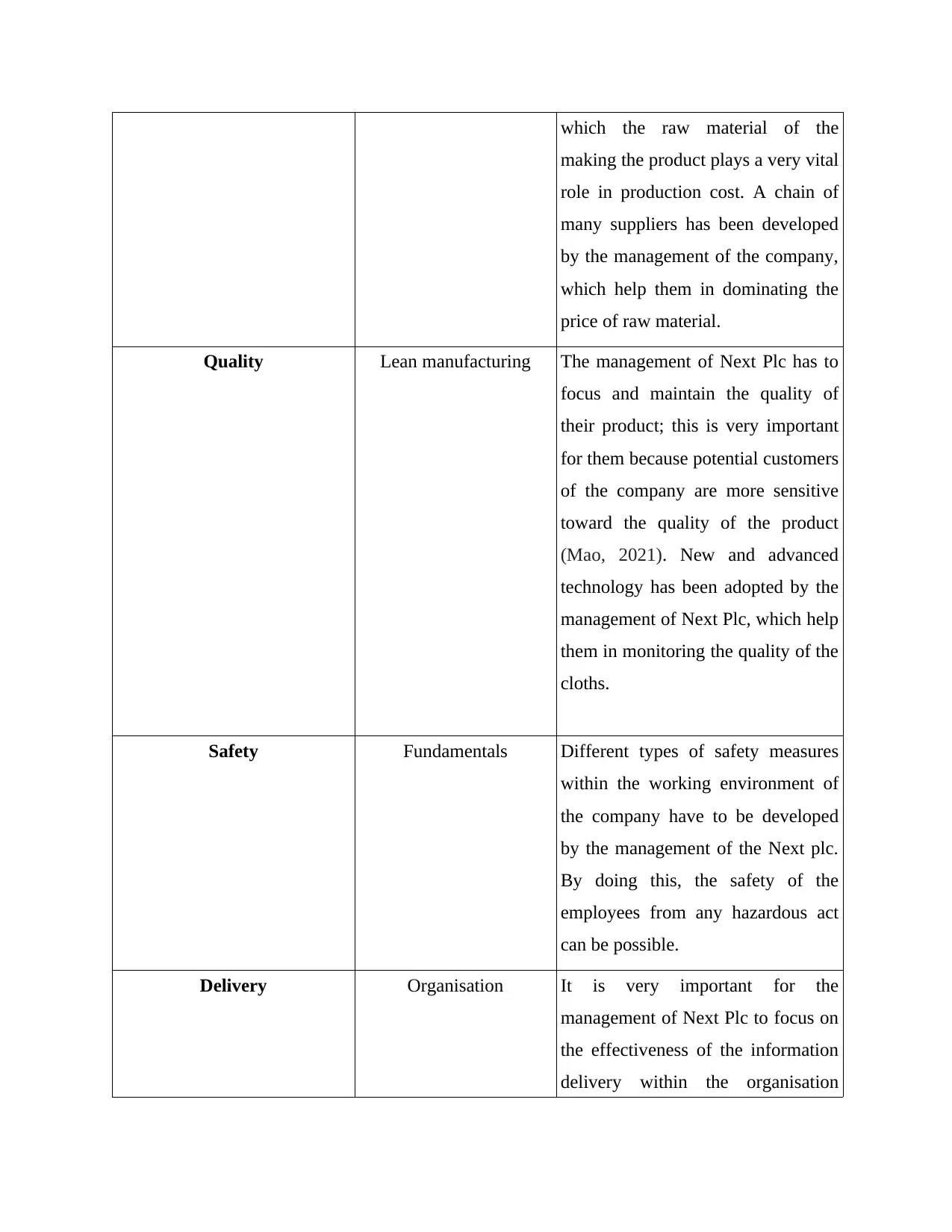
which the raw material of the
making the product plays a very vital
role in production cost. A chain of
many suppliers has been developed
by the management of the company,
which help them in dominating the
price of raw material.
Quality Lean manufacturing The management of Next Plc has to
focus and maintain the quality of
their product; this is very important
for them because potential customers
of the company are more sensitive
toward the quality of the product
(Mao, 2021). New and advanced
technology has been adopted by the
management of Next Plc, which help
them in monitoring the quality of the
cloths.
Safety Fundamentals Different types of safety measures
within the working environment of
the company have to be developed
by the management of the Next plc.
By doing this, the safety of the
employees from any hazardous act
can be possible.
Delivery Organisation It is very important for the
management of Next Plc to focus on
the effectiveness of the information
delivery within the organisation
making the product plays a very vital
role in production cost. A chain of
many suppliers has been developed
by the management of the company,
which help them in dominating the
price of raw material.
Quality Lean manufacturing The management of Next Plc has to
focus and maintain the quality of
their product; this is very important
for them because potential customers
of the company are more sensitive
toward the quality of the product
(Mao, 2021). New and advanced
technology has been adopted by the
management of Next Plc, which help
them in monitoring the quality of the
cloths.
Safety Fundamentals Different types of safety measures
within the working environment of
the company have to be developed
by the management of the Next plc.
By doing this, the safety of the
employees from any hazardous act
can be possible.
Delivery Organisation It is very important for the
management of Next Plc to focus on
the effectiveness of the information
delivery within the organisation
⊘ This is a preview!⊘
Do you want full access?
Subscribe today to unlock all pages.

Trusted by 1+ million students worldwide
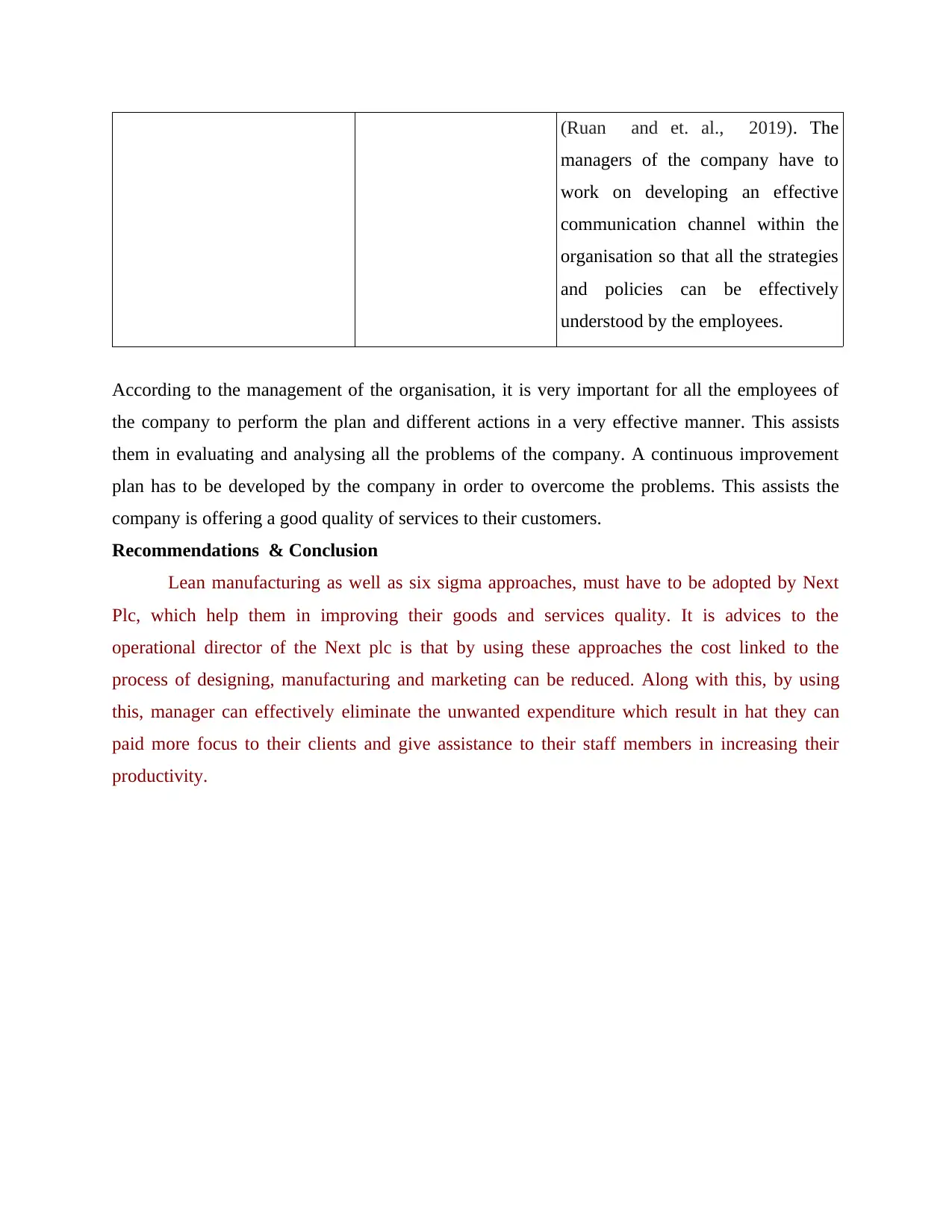
(Ruan and et. al., 2019). The
managers of the company have to
work on developing an effective
communication channel within the
organisation so that all the strategies
and policies can be effectively
understood by the employees.
According to the management of the organisation, it is very important for all the employees of
the company to perform the plan and different actions in a very effective manner. This assists
them in evaluating and analysing all the problems of the company. A continuous improvement
plan has to be developed by the company in order to overcome the problems. This assists the
company is offering a good quality of services to their customers.
Recommendations & Conclusion
Lean manufacturing as well as six sigma approaches, must have to be adopted by Next
Plc, which help them in improving their goods and services quality. It is advices to the
operational director of the Next plc is that by using these approaches the cost linked to the
process of designing, manufacturing and marketing can be reduced. Along with this, by using
this, manager can effectively eliminate the unwanted expenditure which result in hat they can
paid more focus to their clients and give assistance to their staff members in increasing their
productivity.
managers of the company have to
work on developing an effective
communication channel within the
organisation so that all the strategies
and policies can be effectively
understood by the employees.
According to the management of the organisation, it is very important for all the employees of
the company to perform the plan and different actions in a very effective manner. This assists
them in evaluating and analysing all the problems of the company. A continuous improvement
plan has to be developed by the company in order to overcome the problems. This assists the
company is offering a good quality of services to their customers.
Recommendations & Conclusion
Lean manufacturing as well as six sigma approaches, must have to be adopted by Next
Plc, which help them in improving their goods and services quality. It is advices to the
operational director of the Next plc is that by using these approaches the cost linked to the
process of designing, manufacturing and marketing can be reduced. Along with this, by using
this, manager can effectively eliminate the unwanted expenditure which result in hat they can
paid more focus to their clients and give assistance to their staff members in increasing their
productivity.
Paraphrase This Document
Need a fresh take? Get an instant paraphrase of this document with our AI Paraphraser
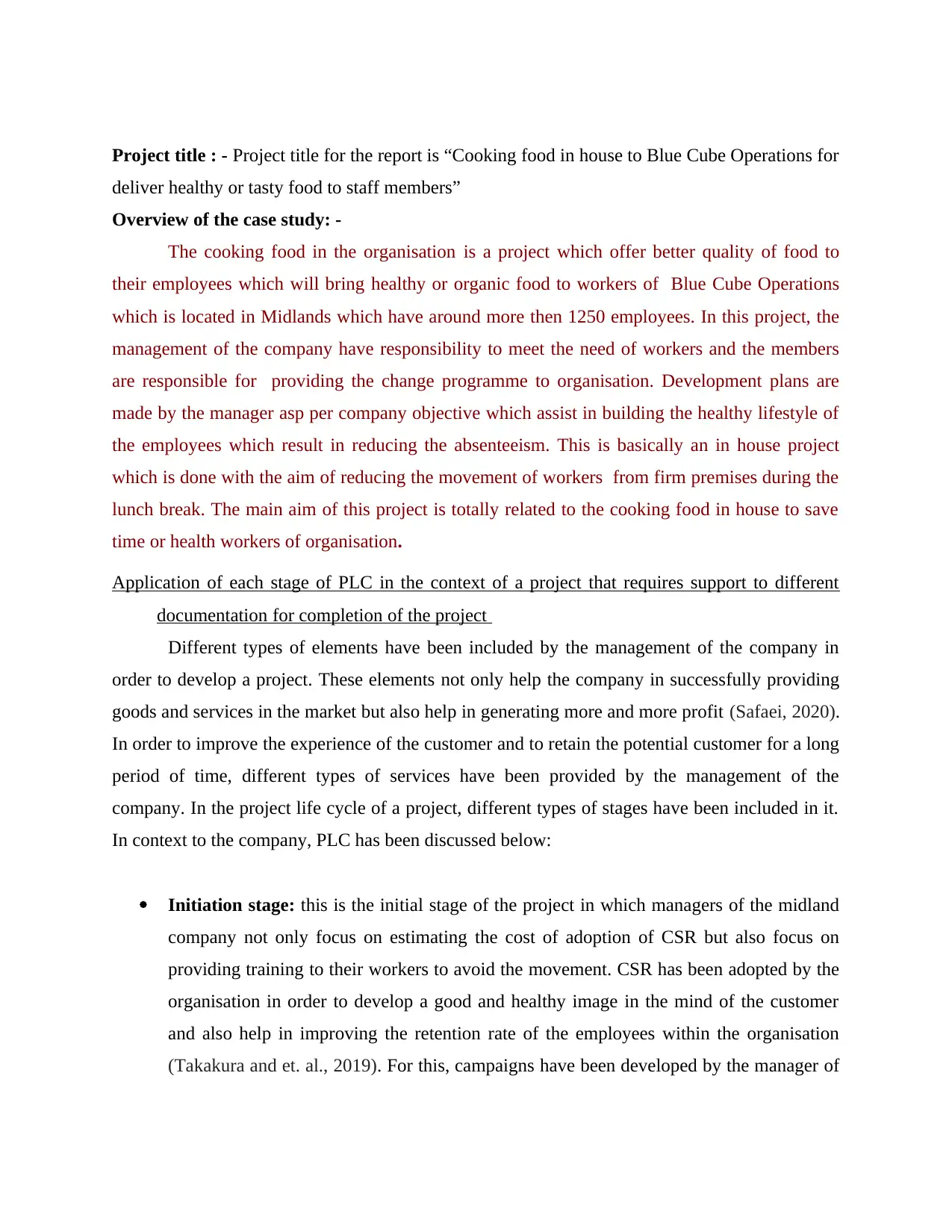
Project title : - Project title for the report is “Cooking food in house to Blue Cube Operations for
deliver healthy or tasty food to staff members”
Overview of the case study: -
The cooking food in the organisation is a project which offer better quality of food to
their employees which will bring healthy or organic food to workers of Blue Cube Operations
which is located in Midlands which have around more then 1250 employees. In this project, the
management of the company have responsibility to meet the need of workers and the members
are responsible for providing the change programme to organisation. Development plans are
made by the manager asp per company objective which assist in building the healthy lifestyle of
the employees which result in reducing the absenteeism. This is basically an in house project
which is done with the aim of reducing the movement of workers from firm premises during the
lunch break. The main aim of this project is totally related to the cooking food in house to save
time or health workers of organisation.
Application of each stage of PLC in the context of a project that requires support to different
documentation for completion of the project
Different types of elements have been included by the management of the company in
order to develop a project. These elements not only help the company in successfully providing
goods and services in the market but also help in generating more and more profit (Safaei, 2020).
In order to improve the experience of the customer and to retain the potential customer for a long
period of time, different types of services have been provided by the management of the
company. In the project life cycle of a project, different types of stages have been included in it.
In context to the company, PLC has been discussed below:
Initiation stage: this is the initial stage of the project in which managers of the midland
company not only focus on estimating the cost of adoption of CSR but also focus on
providing training to their workers to avoid the movement. CSR has been adopted by the
organisation in order to develop a good and healthy image in the mind of the customer
and also help in improving the retention rate of the employees within the organisation
(Takakura and et. al., 2019). For this, campaigns have been developed by the manager of
deliver healthy or tasty food to staff members”
Overview of the case study: -
The cooking food in the organisation is a project which offer better quality of food to
their employees which will bring healthy or organic food to workers of Blue Cube Operations
which is located in Midlands which have around more then 1250 employees. In this project, the
management of the company have responsibility to meet the need of workers and the members
are responsible for providing the change programme to organisation. Development plans are
made by the manager asp per company objective which assist in building the healthy lifestyle of
the employees which result in reducing the absenteeism. This is basically an in house project
which is done with the aim of reducing the movement of workers from firm premises during the
lunch break. The main aim of this project is totally related to the cooking food in house to save
time or health workers of organisation.
Application of each stage of PLC in the context of a project that requires support to different
documentation for completion of the project
Different types of elements have been included by the management of the company in
order to develop a project. These elements not only help the company in successfully providing
goods and services in the market but also help in generating more and more profit (Safaei, 2020).
In order to improve the experience of the customer and to retain the potential customer for a long
period of time, different types of services have been provided by the management of the
company. In the project life cycle of a project, different types of stages have been included in it.
In context to the company, PLC has been discussed below:
Initiation stage: this is the initial stage of the project in which managers of the midland
company not only focus on estimating the cost of adoption of CSR but also focus on
providing training to their workers to avoid the movement. CSR has been adopted by the
organisation in order to develop a good and healthy image in the mind of the customer
and also help in improving the retention rate of the employees within the organisation
(Takakura and et. al., 2019). For this, campaigns have been developed by the manager of
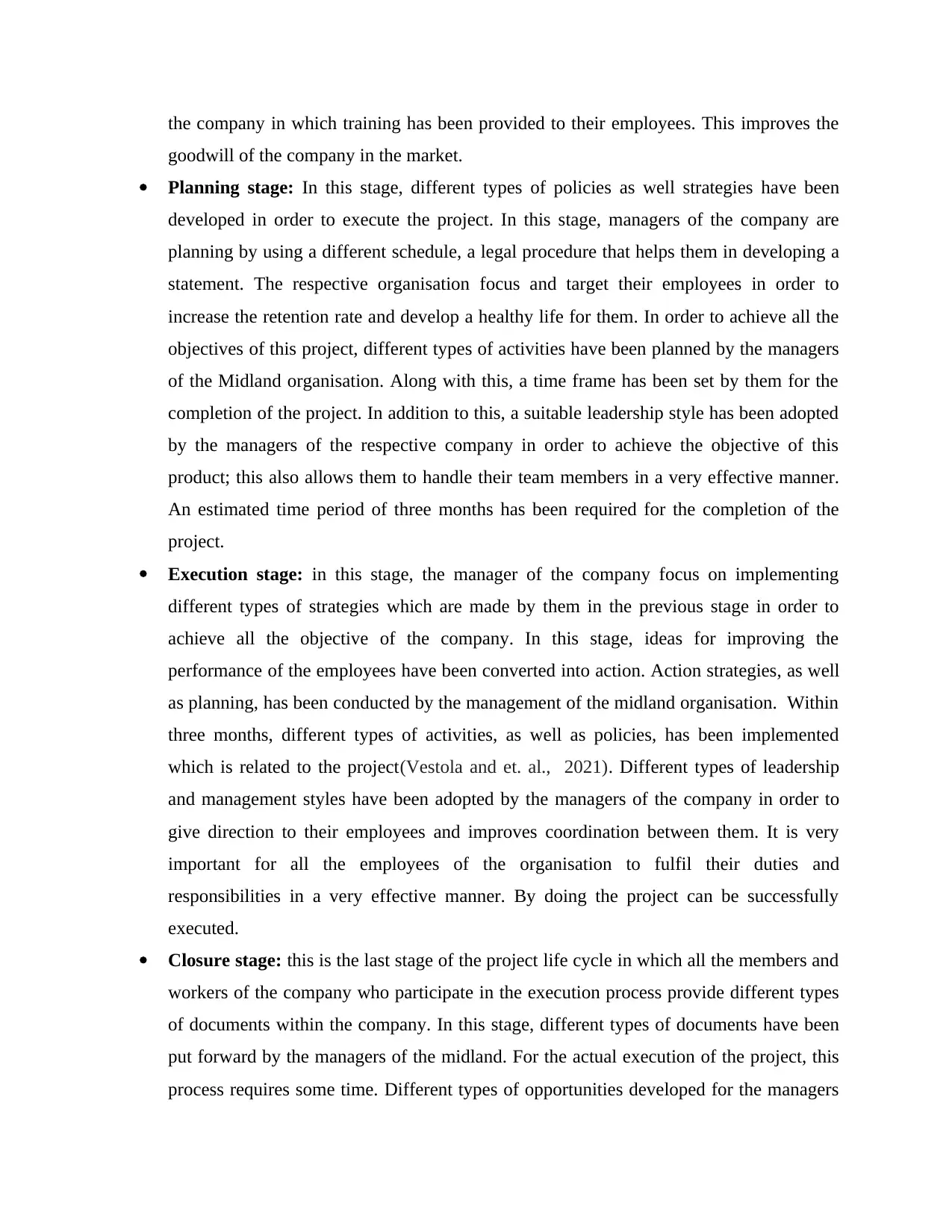
the company in which training has been provided to their employees. This improves the
goodwill of the company in the market.
Planning stage: In this stage, different types of policies as well strategies have been
developed in order to execute the project. In this stage, managers of the company are
planning by using a different schedule, a legal procedure that helps them in developing a
statement. The respective organisation focus and target their employees in order to
increase the retention rate and develop a healthy life for them. In order to achieve all the
objectives of this project, different types of activities have been planned by the managers
of the Midland organisation. Along with this, a time frame has been set by them for the
completion of the project. In addition to this, a suitable leadership style has been adopted
by the managers of the respective company in order to achieve the objective of this
product; this also allows them to handle their team members in a very effective manner.
An estimated time period of three months has been required for the completion of the
project.
Execution stage: in this stage, the manager of the company focus on implementing
different types of strategies which are made by them in the previous stage in order to
achieve all the objective of the company. In this stage, ideas for improving the
performance of the employees have been converted into action. Action strategies, as well
as planning, has been conducted by the management of the midland organisation. Within
three months, different types of activities, as well as policies, has been implemented
which is related to the project(Vestola and et. al., 2021). Different types of leadership
and management styles have been adopted by the managers of the company in order to
give direction to their employees and improves coordination between them. It is very
important for all the employees of the organisation to fulfil their duties and
responsibilities in a very effective manner. By doing the project can be successfully
executed.
Closure stage: this is the last stage of the project life cycle in which all the members and
workers of the company who participate in the execution process provide different types
of documents within the company. In this stage, different types of documents have been
put forward by the managers of the midland. For the actual execution of the project, this
process requires some time. Different types of opportunities developed for the managers
goodwill of the company in the market.
Planning stage: In this stage, different types of policies as well strategies have been
developed in order to execute the project. In this stage, managers of the company are
planning by using a different schedule, a legal procedure that helps them in developing a
statement. The respective organisation focus and target their employees in order to
increase the retention rate and develop a healthy life for them. In order to achieve all the
objectives of this project, different types of activities have been planned by the managers
of the Midland organisation. Along with this, a time frame has been set by them for the
completion of the project. In addition to this, a suitable leadership style has been adopted
by the managers of the respective company in order to achieve the objective of this
product; this also allows them to handle their team members in a very effective manner.
An estimated time period of three months has been required for the completion of the
project.
Execution stage: in this stage, the manager of the company focus on implementing
different types of strategies which are made by them in the previous stage in order to
achieve all the objective of the company. In this stage, ideas for improving the
performance of the employees have been converted into action. Action strategies, as well
as planning, has been conducted by the management of the midland organisation. Within
three months, different types of activities, as well as policies, has been implemented
which is related to the project(Vestola and et. al., 2021). Different types of leadership
and management styles have been adopted by the managers of the company in order to
give direction to their employees and improves coordination between them. It is very
important for all the employees of the organisation to fulfil their duties and
responsibilities in a very effective manner. By doing the project can be successfully
executed.
Closure stage: this is the last stage of the project life cycle in which all the members and
workers of the company who participate in the execution process provide different types
of documents within the company. In this stage, different types of documents have been
put forward by the managers of the midland. For the actual execution of the project, this
process requires some time. Different types of opportunities developed for the managers
⊘ This is a preview!⊘
Do you want full access?
Subscribe today to unlock all pages.

Trusted by 1+ million students worldwide
1 out of 21
Related Documents
Your All-in-One AI-Powered Toolkit for Academic Success.
+13062052269
info@desklib.com
Available 24*7 on WhatsApp / Email
![[object Object]](/_next/static/media/star-bottom.7253800d.svg)
Unlock your academic potential
Copyright © 2020–2025 A2Z Services. All Rights Reserved. Developed and managed by ZUCOL.




